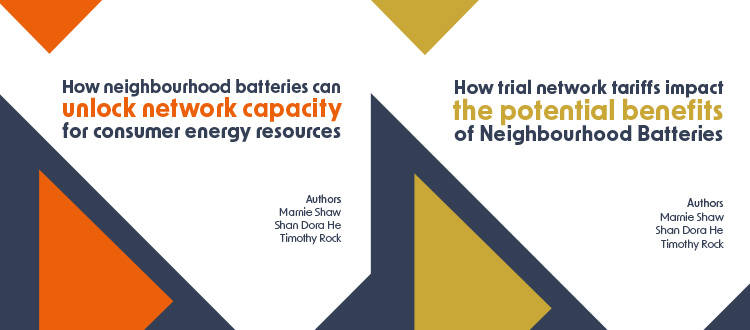
17 July 2024
Neighbourhood batteries (NBs) have the potential to offer many benefits such as allowing more rooftop solar, supporting electrification and sharing the benefits of energy storage with consumers. Two new reports by the Battery Storage and Grid Integration Program provide guidance as to what conditions are necessary in order to unlock the benefits of NBs.
By running simulations of NBs under a range of realistic low voltage scenarios and delving into the various NB tariffs trialled by five Distributed Network Service Providers across Australia, our researchers sought to understand how this technology can maximise benefits for all stakeholders including consumers.
In this article we present key takeaways and recommendations from two new reports:
- How trial network tariffs impact the potential benefits of Neighbourhood Batteries
- How neighbourhood batteries can unlock network capacity for Consumer Energy Resources
Report 1: How trial network tariffs impact the potential benefits of Neighbourhood Batteries
- Researchers at the Battery Storage and Grid Integration Program analysed five network tariffs trialled by Australian Distributed Network Service Providers – Ausgrid, Jemena, Citipower and Powercor, Essential Energy and Evoenergy.
- The objective of the research was to analyse how effective each tariff was at incentivising the flexible behaviour of neighbourhood batteries, in particular to reduce peak demand on the network.
- While the methodologies and regulatory environments differ, the move towards more sophisticated tariff structures, such as time-of-use (TOU) energy charges and time-varying demand charge tariffs, is a common theme globally.
- The tariffs trialled were as follows:
- One-way flat rate tariff
- Two-way time-of-use tariff (two-way tariffs incentivise for charging during solar soaking, or daylight hours, and for discharging during the evening peak. A time-of-use tariff charges different prices for electricity usage depending on the time of day)
- Two-way time-of-use tariff with seasonal demand charge (a seasonal demand charge is set by the highest power demand in winter and summer)
- Two-way time-of-use tariff with two-way demand charge (a demand charge is charging more for electricity at peak periods, typically between 5 – 8pm)
- Two-way (charging & discharging) flat rate with one-way demand charge.
Key takeaways
- Complex tariffs may not be the best approach for customers.
- By shifting the complexity of tariff management onto battery energy management systems households may be able to benefit from optimised network usage and cost savings without the burden of understanding and responding to complicated pricing structures.
- This study used simulations to analyse these trial tariffs, assessing impact on peak demand reduction and financial outcomes for stakeholders. There were three major findings from the analysis:
- Two-way TOU tariffs resulted in a significant reduction in network peak demand and payment to the battery owner.
- A two-way demand charge further reduced network peak demand and increased the payment to the battery owner.
- All tariffs resulted in a similar level of local solar utilisation, that is the proportion of total household electricity requirement met by locally generated rooftop solar was not influenced by different tariffs.
- Further research is necessary to verify results and determine economic viability. Based on further results the goal is to generate a recommendation for a single NEM-wide neighbourhood battery network tariff.
Find out more about tariffs here: Network tariff report methodology paper.
Report 2: How neighbourhood batteries can unlock network capacity for consumer energy resources
- The Battery Storage and Grid Integration Program conducted research to assess if what has been promised of this technology i.e. allowing more rooftop solar and supporting electrification by unlocking network capacity, is realistic under current battery operation models.
- The report is based on simulations of a neighbourhood battery operating in realistic Australian low-voltage networks under a range of scenarios.
Key takeaways
- To ensure NBs increase network hosting capacity, the following factors must be taken into consideration:
- The capacity of the NB
- The operational modes of the NB
- The NB’s location within the electrical network
- Network tariffs
- The number of feeder households with rooftop solar and the size of those systems.
- Results indicate that operating the battery only according to price signals can decrease hosting capacity. However, two-way network tariffs can help avoid this.
- NBs may be particularly helpful in unlocking network capacity in regions with a high density of consumer energy resources or significant reverse power flows and voltage issues. With the anticipated increase in electric vehicles charging demand potentially pushing network thermal and voltage limits, NBs could offer a strategic solution.
Recommendations
1: To ensure NBs are operated to unlock network capacity for the benefit of all energy users policies should consider a) the position of NBs, ensuring they are installed in parts of the network where they will provide benefits (better visibility of low voltage networks will help here). b) battery operation modes, and c) distribution network tariffs.
2: We acknowledge that complex tariff structures are burdensome for many energy users. By shifting the complexity of tariff management onto battery management systems energy users may be able to benefit from optimised network usage and cost savings without the burden of understanding and responding to complicated pricing structures.
3: Further research is required with the goal to generate a single NEM-wide optimised network tariff, with a two-way time-of-use tariff structure.
Thank you to Energy Consumers Australia for funding this research.
